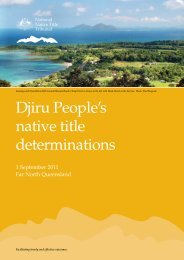Biodiveristy_State of Environment report - Mission Beach Cassowaries
Biodiveristy_State of Environment report - Mission Beach Cassowaries
Biodiveristy_State of Environment report - Mission Beach Cassowaries
- No tags were found...
Create successful ePaper yourself
Turn your PDF publications into a flip-book with our unique Google optimized e-Paper software.
NR&M are conducting research in the Palmerston section<strong>of</strong> the WHA to determine the ecological impacts that feralpigs have on the rainforest. These results will helpdetermine the requirements for control. Preliminary resultshave indicated that pigs may not greatly utilise the largerareas <strong>of</strong> the WHA. It appears that feral pigs mainly utilisethe rainforest fringes, such as tracks and edges. This istremendous news for conservation <strong>of</strong> the WHA and forcontrolling feral pigs, but further research is required. TheNational Park areas are too large and inaccessible toconduct an effective eradication program withoutexorbitant expense. Baiting with affordable poisons canalso affect non-target wildlife. Pig hunting is not permittedin National Parks because <strong>of</strong> the danger from dogs andirresponsible hunters to wildlife, particularly cassowaries.A low level <strong>of</strong> illegal hunting in parks does still occur.Control <strong>of</strong> pigs in National Parks by QPWS is mainlyundertaken opportunistically with shooting when pigs areencountered, or are <strong>report</strong>ed to be causing a problem.QPWS has two eradication programs also operating, at<strong>Mission</strong> <strong>Beach</strong> to Kurrimine, and around Josephine Falls toElla bay, which is through trapping <strong>of</strong> the pigs in theNational parks, and on neighbouring properties.There has been recent Federal commitment to the control<strong>of</strong> pigs with the release <strong>of</strong> the 'Threat Abatement Plan forPredation, Habitat Degradation, Competition and DiseaseTransmission by Feral Pigs' (2005) by the Department <strong>of</strong><strong>Environment</strong> and Heritage (DEH). "Five main objectivesare proposed to manage the threat by feral pigs:1. to prevent feral pigs from establishing in areas wherethey currently do not occur or are in low eradicablenumbers, and where they are likely to pose a threat tobiodiversity; especially where they would impact onnationally listed threatened species and ecologicalcommunities2. to integrate feral pig management plans and theirimplementation into natural resource planning andinvestment at the regional, state and territory, andnational level through consultation and liaison with keystakeholders3. to increase awareness and understanding <strong>of</strong> landmanagers and the general community about the damagethat feral pigs cause and management options4. to quantify the impacts feral pigs have on biodiversity(especially nationally listed threatened species andecological communities) and determine the relationshipbetween feral pig density and the level <strong>of</strong> damage5. to improve the effectiveness, efficiency andhumaneness <strong>of</strong> techniques and strategies for managingthe environmental damage due to feral pigs."(DEH Website, 2005)Council acknowledges its responsibility to enforce control<strong>of</strong> pigs under <strong>State</strong> legislation. Council endeavours tosupport the Community Feral Pig Trapping Program. Thisprogram is currently under review in order to betterallocate resources. The traps bought for the program havesince been absorbed by the community, and most are nolonger at hand for future strategic efforts. Council only hastwo traps but is planning to purchase two more. WetTropics management will also have four traps available.The main control programs for pigs shall be throughtrapping, poisoning, hunting and fencing. Particularattention will be paid to the type <strong>of</strong> attractant used in trapsto avoid attracting cassowaries. All traps must be <strong>of</strong> aDepartment <strong>of</strong> Natural Resources and Mines approved typeand must also be checked at least daily (Hyde, 2002).Council provides pig traps to private landholders on requestwhere pigs are coming out <strong>of</strong> the WHA or from Councilland. Pigs on private land are the landholder'sresponsibility. This aspect <strong>of</strong> the program is basically topromote community relations.Cats, Wild Dogs/DingoesNo control programs are required at present, though <strong>report</strong>s<strong>of</strong> these animals should be monitored in case their numbersincrease. Exceptions may be warranted in cassowary areasif feral dogs are known to be causing problems.Cane ToadsCane Toad control is unlikely to be effective because <strong>of</strong>toad numbers and the area they are distributed over.Biological control is being researched by the CSIRO.“CSIRO scientists are working with gene technology t<strong>of</strong>ind a biological control method. So far researchers haveselected several genes that could be used to interfere withthe metamorphosis from tadpole to adult cane toad. Theyare currently looking at how specific these genes are tocane toads.” …“Australian ranaviruses are naturally-occurring viruses thatcan infect amphibians and fish. Researchers are working onweakening (attenuating) a ranavirus so that, if infected,other non-target amphibians and fish will not suffer fromits effects. Toads themselves will be affected by theresponse to the toad-gene carried by the virus, rather thanby the weakened virus itself.” (CSIRO Website, 2005)As it is vital that toads are the only species affected, it isnot expected that any release <strong>of</strong> such methods will occurfor another ten years, assuming that the research iseffective. Testing to ensure native species are not affectedwill be time-consuming.Indian Myna BirdsNo actions exist or are planned in the Shire for Myna birds.Trapping to control the birds has proved unsuccessful inthe past. The bird is not declared as a pest, which meansthere are no control programs in place. There is somepublic pressure towards getting the bird declared.Rec: NR&M declare Indian Myna Birds a pest species -NR&MIndian Myna Bird47



